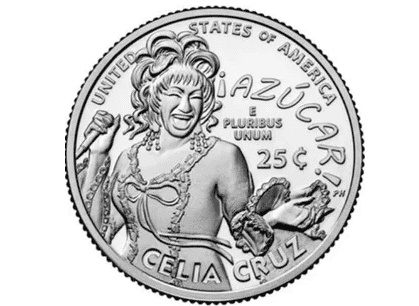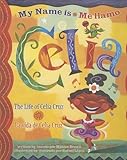In this post: Learn about singer Celia Cruz and her contributions to Latin music in the United States and beyond! Plus books and songs inside! Post contains affiliate links.
One of the most popular Hispanic/Latino artists in the world today is the late Celia Cruz, the world-renowned “Queen of Salsa” who helped spread appreciation for the genre of Salsa music all over the world.

The upcoming Llamitas Level 4 Curriculum (due to launch summer 2025) includes the theme ritmo y cultura. It also features a biography of Celia Cruz to expose students to her legacy and work, as well as the musical genre of Salsa.
These activities encourage upper elementary students to complete creative writing assignments and other hands-on activities that help them to become more familiar with the theme of Salsa and Celia Cruz. Stay tuned for release updates!
Table of Contents
What is Salsa music?
Salsa is a popular style of dance music that is widely enjoyed by Latinos of different ethnicities. It mainly derives from the dance music of Cuba, Puerto Rico, the Dominican Republic, and other areas of the Caribbean, where musical roots go all the way back to Africa!
Salsa music also incorporates influences from Spanish and Middle Eastern music. It has lively rhythms that make people get up and dance. Salsa is popular at family gatherings and celebraciones where people get together to enjoy music and dancing.
Who was Celia Cruz?
Celia Cruz was an Afro-Cuban singer who emigrated from Cuba to the United States during the early stages of her career. She became globally famous as the “Queen of Salsa.”
She was loved by her fans for her impressive vocal range, her sweet personality, and her lifelong devotion to her music and cultural heritage.
Children’s Books about Celia Cruz
To learn more about Celia’s life and legacy, we recommend the following children’s books:
- Me llamo Celia by Monica Brown
This bilingual (Spanish-English text) picture book has stunning and vibrant illustrations throughout to captivate younger readers. Perfect for ages 5-8.
- Used Book in Good Condition
- Hardcover Book
- Brown, Monica (Author)
- English (Publication Language)
- 32 Pages – 10/30/2004 (Publication Date) – Cooper Square Publishing LLC (Publisher)
- Celia Cruz Queen of Salsa by Veronica Chambers
Written in English, this longer picture book is perfect for ages 5-8. A sweet introduction and overview of Celia’s life and career.
- Chambers, Veronica (Author)
- English (Publication Language)
- 40 Pages – 07/19/2007 (Publication Date) – Puffin Books (Publisher)
- Who was Celia Cruz? by Pam Pollack
Ideal for older readers 7+. This chapter book, written in English, includes pencil illustrations to break up the text. It is a deeper dive for young readers into the life and success of the legendary Celia Cruz.
- Pollack, Pam (Author)
- English (Publication Language)
- 112 Pages – 08/04/2020 (Publication Date) – Penguin Workshop (Publisher)
- The Life of/La Vida De Celia (Lil’ Libros) by Patty Rodriguez
Perfect bilingual board book for toddlers and ‘first words’. The Lil’ Libros collection always brings vibrant illustrations with key vocabulary in Spanish and English on every page.
- Rodriguez, Patty (Author)
- English (Publication Language)
- 22 Pages – 01/02/2018 (Publication Date) – Lil’ Libros (Publisher)
Celia loved children and she performed on the children’s television program Sesame Street several times. You can watch some of these appearances here:
What was Celia’s childhood like?
Celia’s full name was actually Úrsula Hilaria Celia Caridad Cruz Alfonso. She was born on October 21, 1925 in the Santos Suárez neighborhood of Havana, Cuba to a family of Afro-Cuban descent.
In Havana, she grew up listening to a wide variety of Cuban musical genres. Her early childhood musical influences included the rhythmic son, rumba, cha-cha-chá, and mambo. Also the soulful and romantic bolero, and the traditional danzón, which blended African rhythms with European classical arrangements.
Celia loved to sing and she spent all her time as a child singing. Although she attended the Normal School for Teachers in Havana with the goal of becoming a school teacher, her true love was always music. She dreamed of a career as a singer.
In the 1940’s, while Celia was in her late teens, she won a singing contest on a Cuban radio program known as “La hora del té.” This lucky break encouraged her to interrupt her studies in education to pursue a musical career.
Celia’s Career
Celia got her first big break in 1950 when she became the lead singer in the popular Cuban band “La Sonora Matancera”. Celia was the first Black person to appear as the lead singer for this band, which was a historical achievement.
She soon earned national fame and the love of fans across her native Cuba, thanks to her exceptional voice and vocal range that could handle even the most difficult melodies.
Celia’s first full-length album recorded with La Sonora Matancera was “Canta Celia Cruz,” released in 1956.
Celia also performed with the orchestra at the famous Tropicana nightclub in Havana. It was widely known and visited by celebrities and luminaries from all around the world in the 1950s.
Celia had the opportunity to tour various countries with La Sonora Matancera, and sang with the band frequently on radio and TV programs. She was also featured with the orchestra in five Mexican films produced in the 1950s.
In 1959, a new government took over Cuba, and many of the nation’s artists had to flee Havana in order to find work in other countries. Celia Cruz eventually settled in the United States, in Fort Lee, New Jersey, just outside of New York City.
While working with La Sonora, Celia met her husband Pedro Knight, a trumpet player in the orchestra. She and Pedro married in 1962, and he became her musical director and manager after leaving La Sonora Matancera in 1965.
During those early years in the United States, Celia recorded several albums with the popular bandleader Tito Puente. However it wasn’t until the early 1970s that she became associated specifically with the genre of Salsa. It was around this time that Salsa as a genre made a major splash in the international musical scene.
Celia’s career opened up to a whole new generation of followers at this time. She performed at New York’s Carnegie Hall in the Latin opera Hommy (1973), which was a version of the Who’s rock opera Tommy, and recorded updated Salsa versions of classics.
She collaborated with Dominican salsero Johnny Pacheco on various albums, starting with Celia & Johnny (1974). From this album came one of Celia’s signature songs called “Químbara.”
Celia also recorded three chart-topping albums with Puerto Rican trombonist Willie Colón, released between 1977 and 1987.
Celia’s vocal range was described as operatic. She had the ability to easily stretch and hold notes from the highest to the lowest end of the musical register. Her dynamic style of improvising rhymed lyrics on the spot during performances also distinguished her as a unique entertainer.
Her signature habit of calling out the word “azúcar” in the middle of a song or concert also marked her unique style.
It was not long before Celia emerged as a leading figure in New York’s vibrant salsa scene. Crowds would shout the word “azúcar” at her performances in her honor.
Celia’s Costumes
Celia also became famous for her flashy and colorful costumes. She wore wigs in all colors, sequined gowns, and custom-built high heeled shoes.
Celia’s outfits garnered so much attention that the Smithsonian in Washington DC holds several items from her wardrobe in their permanent collection. The institution has also hosted public exhibitions of these pieces.
Celia’s Awards
In 1988, the BBC released a documentary about Celia’s life, titled “My Name Is Celia Cruz” (1988). Celia also appeared in the movies “The Mambo Kings” (1992) and “The Perez Family” (1995).
During her international career, Celia Cruz earned three Grammy Awards and four Latin Grammy Awards.
Tributes to Celia Cruz
Shortly before her death on July 16, 2003, in Fort Lee, New Jersey, Celia wrote her autobiography, Celia: My Life. It was published in Spanish in 2004, then translated to English.
- Hardcover Book
- Cruz, Celia (Author)
- English (Publication Language)
- 304 Pages – 07/06/2004 (Publication Date) – Rayo (Publisher)
In 2011 the United States postal service paid tribute to Celia Cruz by issuing a U.S. postage stamp bearing her image.
In 2023, Celia was selected by the United States mint to be one of a series of trailblazing women featured as part of its American Women Quarters Program. Her image was put on the face of a U.S. quarter.
When Celia’s coin was released in 2024, she became the first Afro-Latina in history to be represented on any U.S. currency.

Celia Cruz was also loved for her generosity of spirit. She gave generously to charities, and always spoke kindly of all people. She was humble and kind, and loved by all who came in contact with her; from her personal staff to her international fans.
Throughout her entire career, Celia dedicated songs to her native Cuba, but she was never allowed to enter her country again.
Celia Cruz became an international superstar in a musical genre that originated in a poor country, and an industry dominated by men. In spite of this, Celia Cruz became the Queen of Salsa and the most popular Latin American artist of the twentieth century.
Celia Cruz: Greatest Hits
Of course, no article on Celia Cruz would be complete without a playlist of fun songs that you can listen to in order to help you get to know the music of this very beloved salsera!
Our favorite songs by Celia Cruz to listen and dance to with children include:
- Caramelos
- El que siembra su maíz
- La vida es un carnaval
- Burundanga
- Químbara
- Yerberito moderno
- Ríe y Llora
- Guantanamera
- Cúcala
- Cuba que lindos son tus paisajes
- Bemba colorá
- Soy antillana
- Besito de coco
Culturally Authentic Spanish Curriculum
Llamitas Spanish provides educational programs that also encourage cultural appreciation and biculturalism.
Lessons include authentic music, folktales, and cultural studies that represent diverse aspects of Hispanic/Latino culture.







